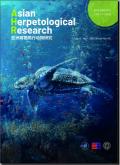旧大陆伪鲨与新世界伪鲨科的关系及其对中国伪鲨物种多样性低估的评述
IF 1.2
3区 生物学
Q2 ZOOLOGY
引用次数: 5
摘要
由于缺乏足够的样本,对假异齿目和双棘目之间关系的评估一直受到阻碍。本文利用2种拟异齿龙的2个线粒体基因(12S和16S rRNA)和1个核基因(c-mos),以及84条蛇类和1条蟒蛇外群序列进行了系统发育分析。我们的研究表明,东南亚的假异齿龙属在南美洲的异齿龙中形成了一个强大的遗传亚分支,表明该属中至少有一个谱系在第三纪早期和中新世中期的温暖时期从新世界(NW)进入或返回旧世界(OW)。该研究还揭示了中国巨齿假鲨种群中较高的种内基因组变异,表明中国巨齿假鲨的物种多样性可能被低估。本文章由计算机程序翻译,如有差异,请以英文原文为准。
Relationship of Old World Pseudoxenodon and New World Dipsadinae, with Comments on Underestimation of Species Diversity of ChinesePseudoxenodon
Assessment of the relationship between Pseudoxenodon and Dipsadinae has been hampered by lack of adequate samples. In this paper, we conducted phylogenetic analyses using two mitochondrial genes (12S and 16S rRNA) and one nuclear gene (c-mos) from thirteen specimens representing two species of Pseudoxenodon , together with 84 sequences of caenophidians and an outgroup sequence of Boa constrictor . Our study suggests that the Southeast Asian genus, Pseudoxenodon forms a robust genetic subclade within South American xenodontines, indicating that at least one lineage within this genus entered or returned to the Old World (OW) from the New World (NW) across the Beringian Land Bridge during the early Tertiary and the warm mid-Miocene. It also reveals the high intraspecific genomic variation within the populations of Pseudoxenodon macrops , indicating that species diversity of Pseudoxenodon in China is likely underestimated.
求助全文
通过发布文献求助,成功后即可免费获取论文全文。
去求助
来源期刊

Asian Herpetological Research
ZOOLOGY-
CiteScore
2.80
自引率
7.10%
发文量
441
审稿时长
>12 weeks
期刊介绍:
AHR aims to provide a forum for herpetologists and related scientists interested in conducting international academic exchanges and joint studies, and a platform for introducing their newly made scientific and technological data, and publishing their research results and achievements in the world, but focusing on the Asian-Pacific Region.
The principal criteria of AHR for acceptance of articles for publication are the quality and significance of the research, breadth of interest of the work to the readership, and the clarity and effectiveness of communication. AHR welcomes submission of manuscripts from authors in all countries of the world, though with a focus on the herpetological studies in the Asian and Pacific Region, including major articles, shorter communications and review articles.
 求助内容:
求助内容: 应助结果提醒方式:
应助结果提醒方式:


